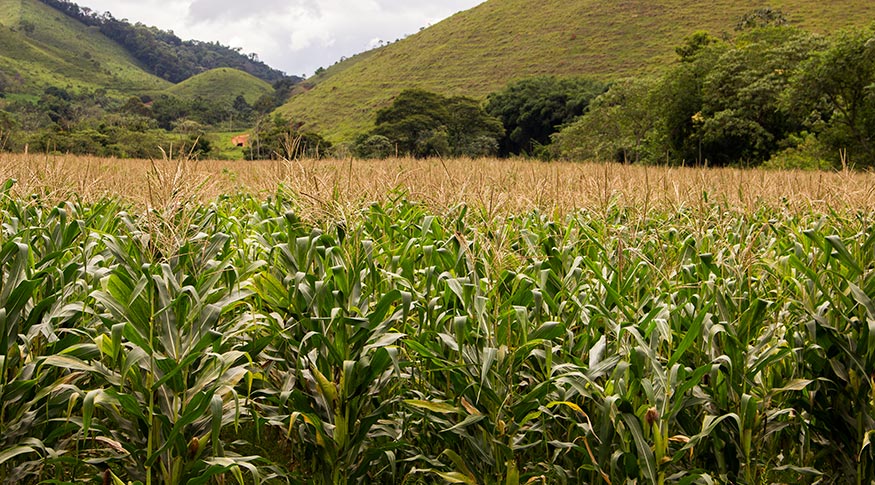Agricultural production
September´s estimate forecasts record harvest of 318.1 million tonnes for 2023
October 10, 2023 09h00 AM | Last Updated: October 10, 2023 03h53 PM

Released today (10) by the IBGE, the Systematic Survey of Agricultural Production reveals that the national crop of cereals, legumes and oilseeds should hit a new record in 2023, adding up to 318.1 million tonnes. The figure is 20.9% higher - or more 54.9 million
tonnes - than that obtained in 2022 (263.2 million tonnes). Compared with August, the estimate pointed out a rise of 1.5%, an increase of 4.8 million tonnes. The production of
soybeans, corn, sorghum, upland cottonseed and wheat also hit records.
The area to be harvested this year should be 77.8 million hectares, representing an increase of 6.3% against the area harvested in 2022 (an increase of 4.6 million hectares), and 0.4% bigger than the August´s estimate (more 338,967 hectares).
Compared with 2022, there were increases of 26.5% for soybeans, 12.3% for upland cottonseed, 43.3% for sorghum, 19.6% for corn, with increases of 10.1% for corn 1st crop and of 22.4% for corn 2nd crop, and 4.8% for wheat, while for paddy rice, there was a decrease of 5.1%.
The output estimate for soybeans was 151.2 million tonnes and, for corn, 131.7 million tonnes (28.0 million tonnes for corn - 1st crop and 103.8 million tonnes for corn - 2nd crop). The output of rice was estimated at 10.1 million tonnes, that of wheat, at 10.5 million tonnes, that of upland cottonseed, at 7.6 million tonnes and that of sorghum, at 4.1 million tonnes.
According to Carlos Barradas, manager of the LSPA, the favorable weather and the harvest of the first and second crops explain the September´s highlights, which were the growth in the production of corn (3.1%), soybeans (0.6%) and cotton (2.1%). He says that the records of corn and soybeans are expected to be consolidated. Despite the reduction of 3.2% in September, the record estimate of 10.5 million tonnes of wheat is still maintained, which will be confirmed at the end of the harvest in November.
“We had a record in the total harvest of grains and in the harvests of corn, soybeans, sorghum, upland cottonseed and, possibly, wheat, with the help of the weather. Having completed the first and second harvests, we should say that corn, soybeans, sorghum and cotton have already consolidated their records. Wheat is still being harvested, expected to end in November. Several factors may still affect the production of wheat, since the crop is very sensitive to the weather,” says Barradas.
He also highlights a monthly growth of 3.1% in the output of sugarcane, reaching 700.4 million tonnes, causing an annual growth of 11.9%.
“It is not a record, but rather a significant milestone. The weather helped a lot the sugarcane crops as well. We also registered a growth of 1.4% in the estimate for coffee, which is hitting 55.9 million sacks. The rise was leveraged by the arabica species, which grew 1.4% in the month and 14.6% in the year. It should be highlighted that this year is of negative biennial bearings, thus expecting a lower production. The canephora species increased 1.5% over the previous month and declined 7.3% in relation to 2022, due to a lower average yield,” completes the LSPA manager.
With a share of 31.3%, Mato Grosso leads national output of grains
The estimated production of cereals, legumes and oilseeds registered a positive annual change in five Major Regions: Central-West (23.2%), South (26.3%), North (21.4%), Southeast (9.2%) and Northeast (7.6%). As to the monthly change, the North Region (0.2%), Central-West (3.2%) and Southeast (0.3%) increased. The South (-0.3%) and Northeast (-0.2%) declined.
Mato Grosso leads the national production of grains with a share of 31.3%, followed by Paraná (14.5%), Goiás (10.3%), Rio Grande do Sul (9.3%), Mato Grosso do Sul (8.8%) and Minas Gerais (6.1%). These states together accounted for 80.3% of the total. As for the participation of the Brazilian Major Regions, the distribution was as follows: Central-West (50.6%), South (26.1%), Southeast (9.5%), Northeast (8.6%) and North (5.2%).
The next release of the LSPA will be on November 9.
About the LSPA
Launched in November 1972 aiming at addressing the demand of users for monthly short-term statistical information, the LSPA provides estimates of planted area, harvested area, amount produced and average yield of products selected based on criteria of economic and social importance for Brazil. It not only follows up each crop investigated in the calendar year of reference, from the intention to plant up to the end of the harvest, yet also the forecast of the harvest in the coming year, for which the months of October, November and December are surveyed. Please access the data on Sidra.




















